Comparing Roles: Leader vs Manager in Management and Operations
VerifiedAdded on 2023/01/12
|10
|2103
|88
Report
AI Summary
This report analyzes the distinctions between the roles of leaders and managers within an organizational context, focusing on operational management. It begins by comparing the characteristics and responsibilities of leaders and managers, providing definitions and highlighting key differences. The report then explores how leadership and management functions apply in various situations, using examples to illustrate their practical application. Different theories and models, such as contingency theory, situational leadership, and systems theory, are discussed to provide a theoretical framework for understanding leadership effectiveness. The report further examines key approaches to operations management, including project management, total quality management, Six Sigma, and lean principles, assessing their value and importance in achieving business objectives. Finally, it investigates the factors within the business environment that impact operational management, such as corporate social responsibility and organizational culture, concluding with a synthesis of the findings and their implications.
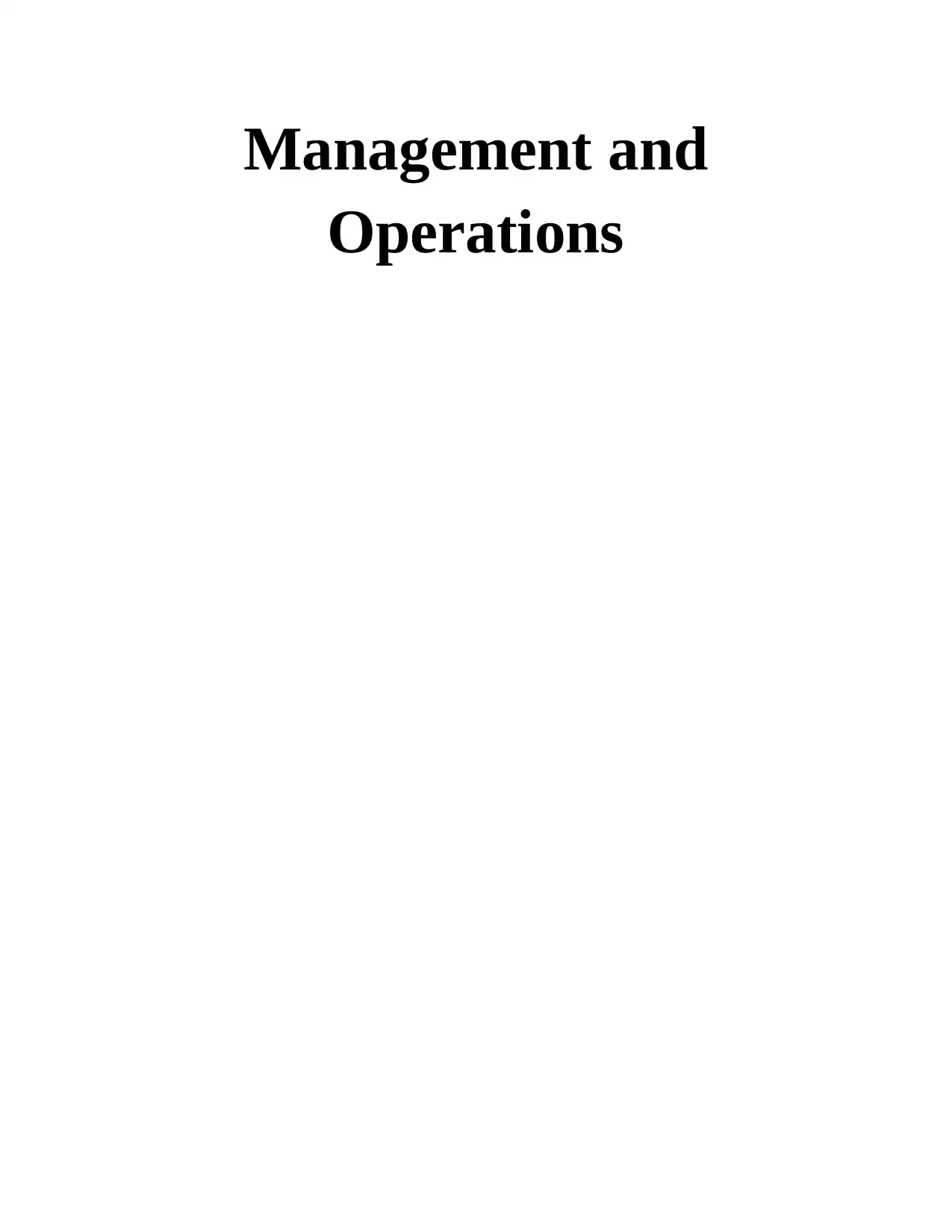
Management and
Operations
Operations
Paraphrase This Document
Need a fresh take? Get an instant paraphrase of this document with our AI Paraphraser
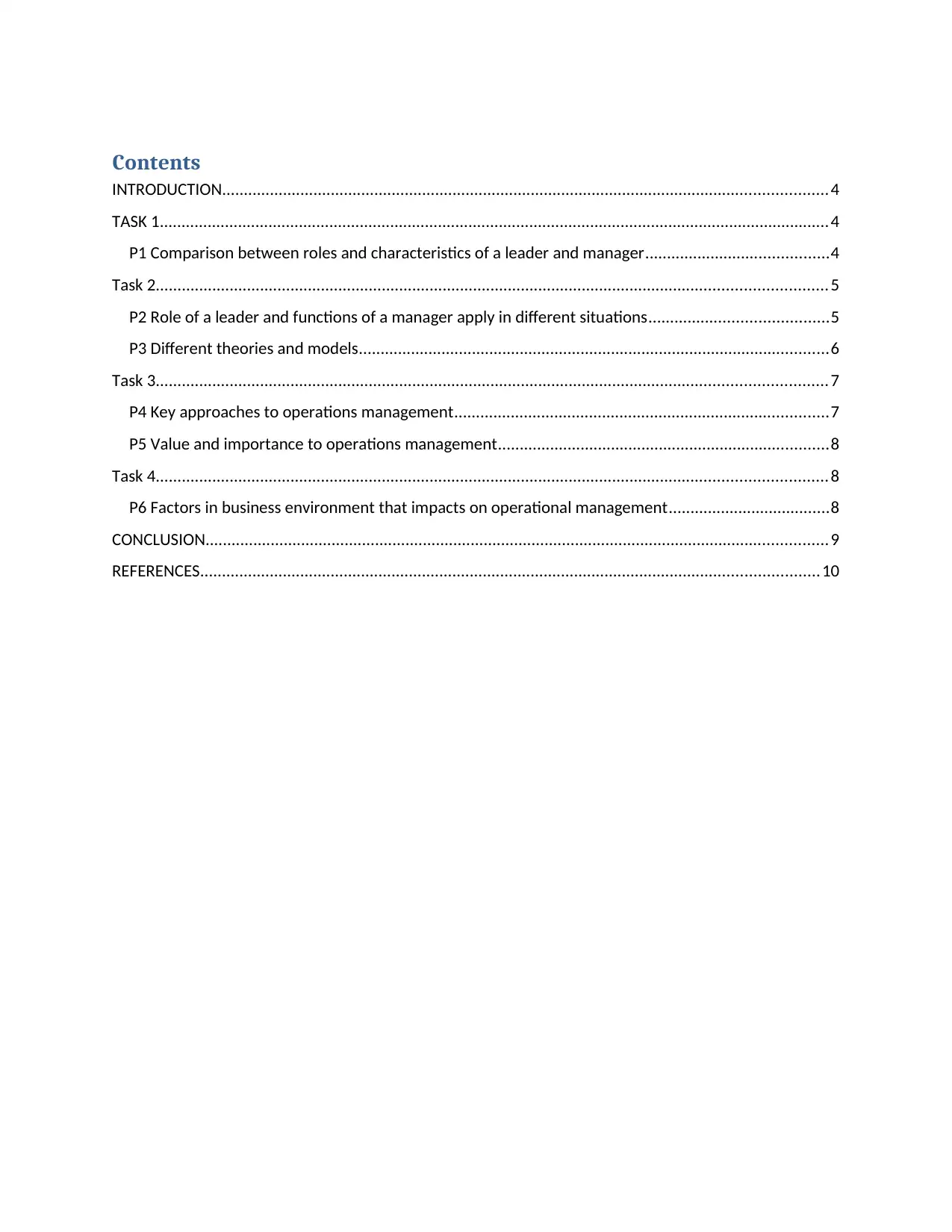
Contents
INTRODUCTION...........................................................................................................................................4
TASK 1..........................................................................................................................................................4
P1 Comparison between roles and characteristics of a leader and manager..........................................4
Task 2..........................................................................................................................................................5
P2 Role of a leader and functions of a manager apply in different situations.........................................5
P3 Different theories and models............................................................................................................6
Task 3..........................................................................................................................................................7
P4 Key approaches to operations management......................................................................................7
P5 Value and importance to operations management............................................................................8
Task 4..........................................................................................................................................................8
P6 Factors in business environment that impacts on operational management.....................................8
CONCLUSION...............................................................................................................................................9
REFERENCES..............................................................................................................................................10
INTRODUCTION...........................................................................................................................................4
TASK 1..........................................................................................................................................................4
P1 Comparison between roles and characteristics of a leader and manager..........................................4
Task 2..........................................................................................................................................................5
P2 Role of a leader and functions of a manager apply in different situations.........................................5
P3 Different theories and models............................................................................................................6
Task 3..........................................................................................................................................................7
P4 Key approaches to operations management......................................................................................7
P5 Value and importance to operations management............................................................................8
Task 4..........................................................................................................................................................8
P6 Factors in business environment that impacts on operational management.....................................8
CONCLUSION...............................................................................................................................................9
REFERENCES..............................................................................................................................................10

⊘ This is a preview!⊘
Do you want full access?
Subscribe today to unlock all pages.

Trusted by 1+ million students worldwide
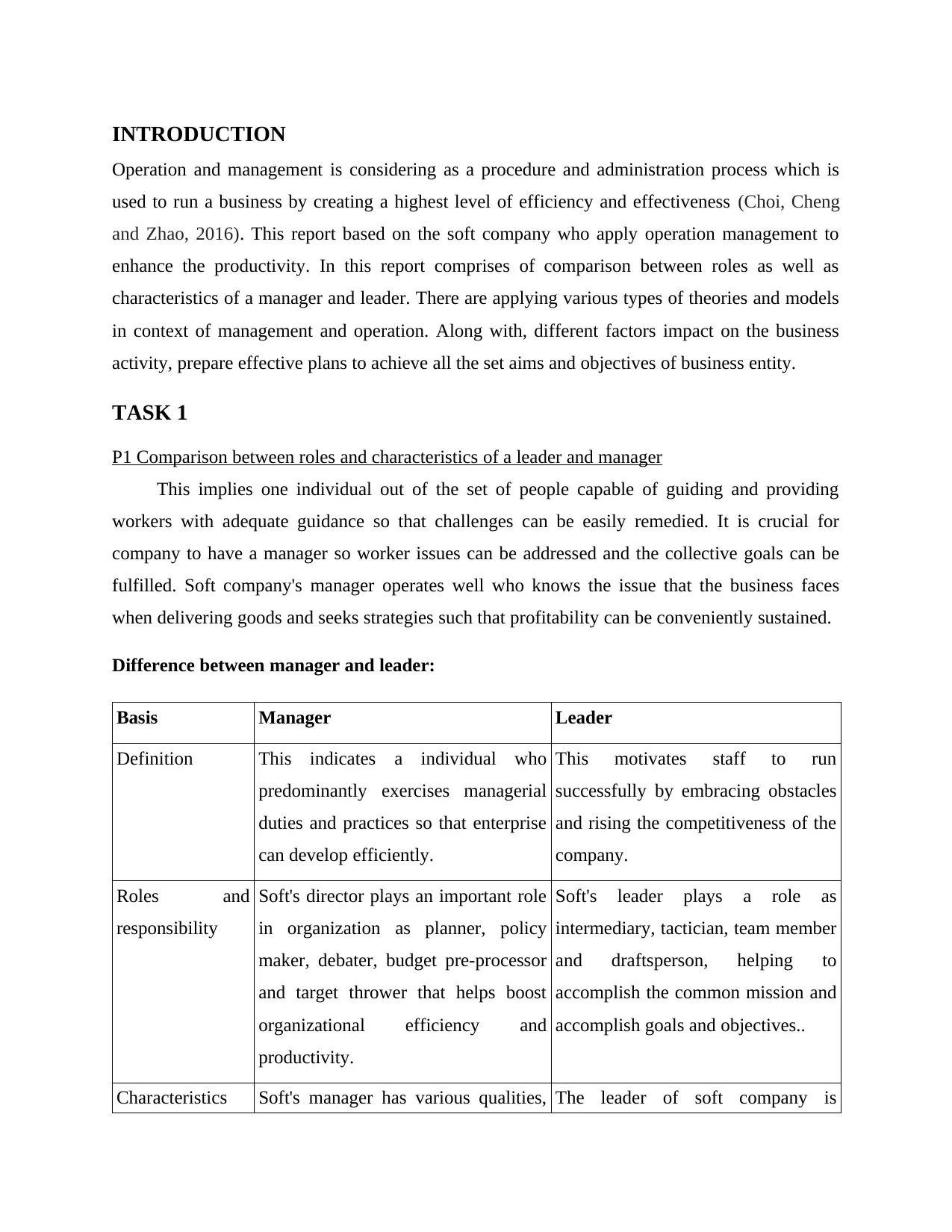
INTRODUCTION
Operation and management is considering as a procedure and administration process which is
used to run a business by creating a highest level of efficiency and effectiveness (Choi, Cheng
and Zhao, 2016). This report based on the soft company who apply operation management to
enhance the productivity. In this report comprises of comparison between roles as well as
characteristics of a manager and leader. There are applying various types of theories and models
in context of management and operation. Along with, different factors impact on the business
activity, prepare effective plans to achieve all the set aims and objectives of business entity.
TASK 1
P1 Comparison between roles and characteristics of a leader and manager
This implies one individual out of the set of people capable of guiding and providing
workers with adequate guidance so that challenges can be easily remedied. It is crucial for
company to have a manager so worker issues can be addressed and the collective goals can be
fulfilled. Soft company's manager operates well who knows the issue that the business faces
when delivering goods and seeks strategies such that profitability can be conveniently sustained.
Difference between manager and leader:
Basis Manager Leader
Definition This indicates a individual who
predominantly exercises managerial
duties and practices so that enterprise
can develop efficiently.
This motivates staff to run
successfully by embracing obstacles
and rising the competitiveness of the
company.
Roles and
responsibility
Soft's director plays an important role
in organization as planner, policy
maker, debater, budget pre-processor
and target thrower that helps boost
organizational efficiency and
productivity.
Soft's leader plays a role as
intermediary, tactician, team member
and draftsperson, helping to
accomplish the common mission and
accomplish goals and objectives..
Characteristics Soft's manager has various qualities, The leader of soft company is
Operation and management is considering as a procedure and administration process which is
used to run a business by creating a highest level of efficiency and effectiveness (Choi, Cheng
and Zhao, 2016). This report based on the soft company who apply operation management to
enhance the productivity. In this report comprises of comparison between roles as well as
characteristics of a manager and leader. There are applying various types of theories and models
in context of management and operation. Along with, different factors impact on the business
activity, prepare effective plans to achieve all the set aims and objectives of business entity.
TASK 1
P1 Comparison between roles and characteristics of a leader and manager
This implies one individual out of the set of people capable of guiding and providing
workers with adequate guidance so that challenges can be easily remedied. It is crucial for
company to have a manager so worker issues can be addressed and the collective goals can be
fulfilled. Soft company's manager operates well who knows the issue that the business faces
when delivering goods and seeks strategies such that profitability can be conveniently sustained.
Difference between manager and leader:
Basis Manager Leader
Definition This indicates a individual who
predominantly exercises managerial
duties and practices so that enterprise
can develop efficiently.
This motivates staff to run
successfully by embracing obstacles
and rising the competitiveness of the
company.
Roles and
responsibility
Soft's director plays an important role
in organization as planner, policy
maker, debater, budget pre-processor
and target thrower that helps boost
organizational efficiency and
productivity.
Soft's leader plays a role as
intermediary, tactician, team member
and draftsperson, helping to
accomplish the common mission and
accomplish goals and objectives..
Characteristics Soft's manager has various qualities, The leader of soft company is
Paraphrase This Document
Need a fresh take? Get an instant paraphrase of this document with our AI Paraphraser
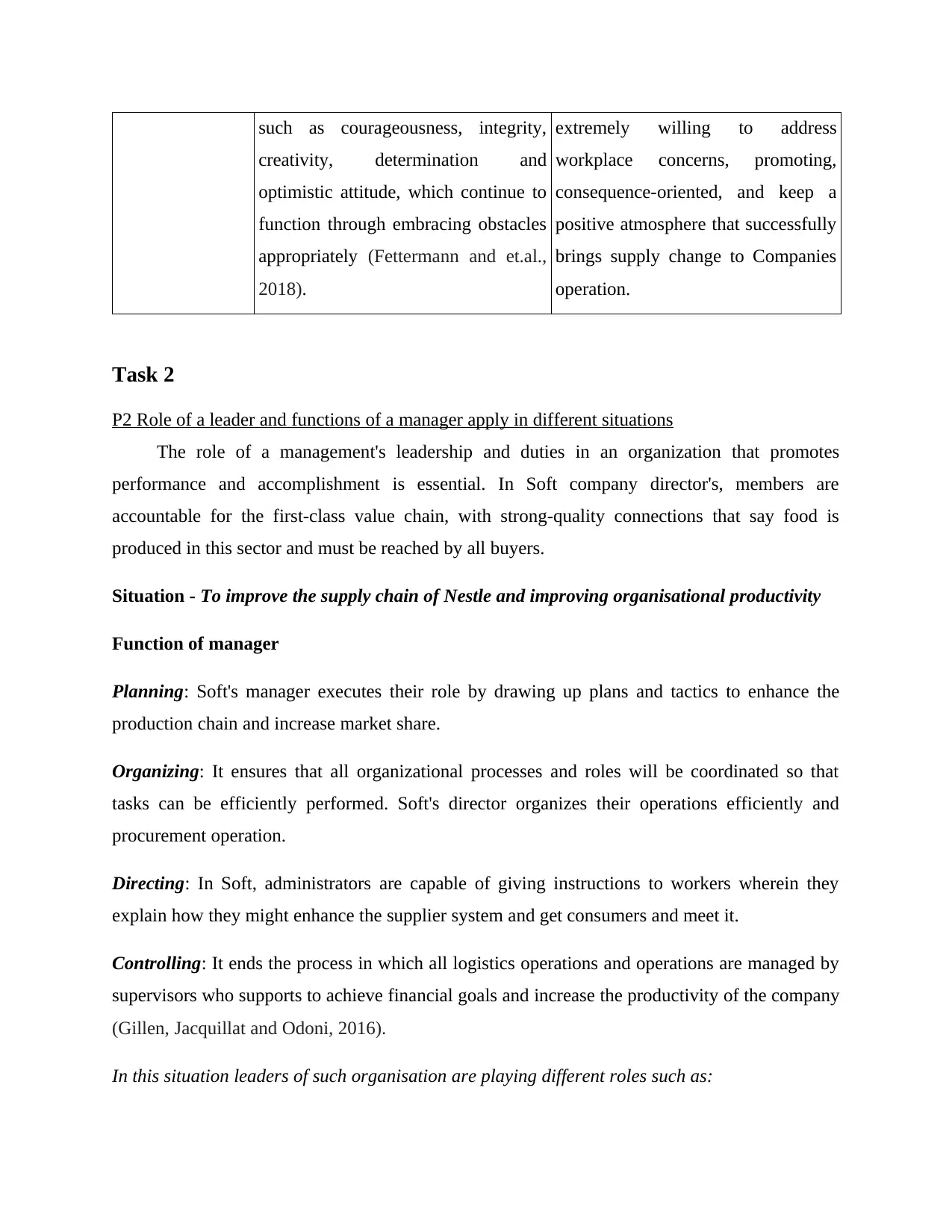
such as courageousness, integrity,
creativity, determination and
optimistic attitude, which continue to
function through embracing obstacles
appropriately (Fettermann and et.al.,
2018).
extremely willing to address
workplace concerns, promoting,
consequence-oriented, and keep a
positive atmosphere that successfully
brings supply change to Companies
operation.
Task 2
P2 Role of a leader and functions of a manager apply in different situations
The role of a management's leadership and duties in an organization that promotes
performance and accomplishment is essential. In Soft company director's, members are
accountable for the first-class value chain, with strong-quality connections that say food is
produced in this sector and must be reached by all buyers.
Situation - To improve the supply chain of Nestle and improving organisational productivity
Function of manager
Planning: Soft's manager executes their role by drawing up plans and tactics to enhance the
production chain and increase market share.
Organizing: It ensures that all organizational processes and roles will be coordinated so that
tasks can be efficiently performed. Soft's director organizes their operations efficiently and
procurement operation.
Directing: In Soft, administrators are capable of giving instructions to workers wherein they
explain how they might enhance the supplier system and get consumers and meet it.
Controlling: It ends the process in which all logistics operations and operations are managed by
supervisors who supports to achieve financial goals and increase the productivity of the company
(Gillen, Jacquillat and Odoni, 2016).
In this situation leaders of such organisation are playing different roles such as:
creativity, determination and
optimistic attitude, which continue to
function through embracing obstacles
appropriately (Fettermann and et.al.,
2018).
extremely willing to address
workplace concerns, promoting,
consequence-oriented, and keep a
positive atmosphere that successfully
brings supply change to Companies
operation.
Task 2
P2 Role of a leader and functions of a manager apply in different situations
The role of a management's leadership and duties in an organization that promotes
performance and accomplishment is essential. In Soft company director's, members are
accountable for the first-class value chain, with strong-quality connections that say food is
produced in this sector and must be reached by all buyers.
Situation - To improve the supply chain of Nestle and improving organisational productivity
Function of manager
Planning: Soft's manager executes their role by drawing up plans and tactics to enhance the
production chain and increase market share.
Organizing: It ensures that all organizational processes and roles will be coordinated so that
tasks can be efficiently performed. Soft's director organizes their operations efficiently and
procurement operation.
Directing: In Soft, administrators are capable of giving instructions to workers wherein they
explain how they might enhance the supplier system and get consumers and meet it.
Controlling: It ends the process in which all logistics operations and operations are managed by
supervisors who supports to achieve financial goals and increase the productivity of the company
(Gillen, Jacquillat and Odoni, 2016).
In this situation leaders of such organisation are playing different roles such as:
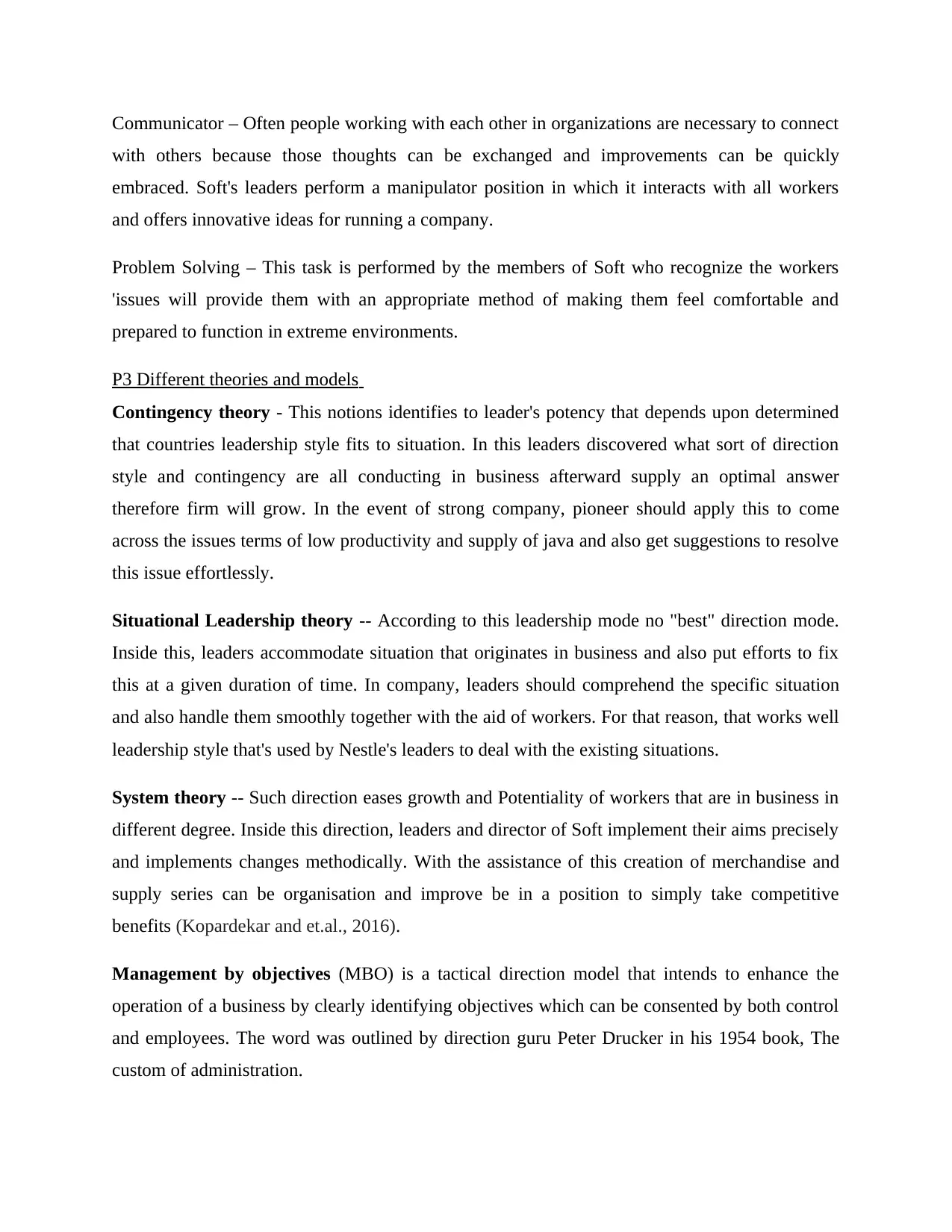
Communicator – Often people working with each other in organizations are necessary to connect
with others because those thoughts can be exchanged and improvements can be quickly
embraced. Soft's leaders perform a manipulator position in which it interacts with all workers
and offers innovative ideas for running a company.
Problem Solving – This task is performed by the members of Soft who recognize the workers
'issues will provide them with an appropriate method of making them feel comfortable and
prepared to function in extreme environments.
P3 Different theories and models
Contingency theory - This notions identifies to leader's potency that depends upon determined
that countries leadership style fits to situation. In this leaders discovered what sort of direction
style and contingency are all conducting in business afterward supply an optimal answer
therefore firm will grow. In the event of strong company, pioneer should apply this to come
across the issues terms of low productivity and supply of java and also get suggestions to resolve
this issue effortlessly.
Situational Leadership theory -- According to this leadership mode no "best" direction mode.
Inside this, leaders accommodate situation that originates in business and also put efforts to fix
this at a given duration of time. In company, leaders should comprehend the specific situation
and also handle them smoothly together with the aid of workers. For that reason, that works well
leadership style that's used by Nestle's leaders to deal with the existing situations.
System theory -- Such direction eases growth and Potentiality of workers that are in business in
different degree. Inside this direction, leaders and director of Soft implement their aims precisely
and implements changes methodically. With the assistance of this creation of merchandise and
supply series can be organisation and improve be in a position to simply take competitive
benefits (Kopardekar and et.al., 2016).
Management by objectives (MBO) is a tactical direction model that intends to enhance the
operation of a business by clearly identifying objectives which can be consented by both control
and employees. The word was outlined by direction guru Peter Drucker in his 1954 book, The
custom of administration.
with others because those thoughts can be exchanged and improvements can be quickly
embraced. Soft's leaders perform a manipulator position in which it interacts with all workers
and offers innovative ideas for running a company.
Problem Solving – This task is performed by the members of Soft who recognize the workers
'issues will provide them with an appropriate method of making them feel comfortable and
prepared to function in extreme environments.
P3 Different theories and models
Contingency theory - This notions identifies to leader's potency that depends upon determined
that countries leadership style fits to situation. In this leaders discovered what sort of direction
style and contingency are all conducting in business afterward supply an optimal answer
therefore firm will grow. In the event of strong company, pioneer should apply this to come
across the issues terms of low productivity and supply of java and also get suggestions to resolve
this issue effortlessly.
Situational Leadership theory -- According to this leadership mode no "best" direction mode.
Inside this, leaders accommodate situation that originates in business and also put efforts to fix
this at a given duration of time. In company, leaders should comprehend the specific situation
and also handle them smoothly together with the aid of workers. For that reason, that works well
leadership style that's used by Nestle's leaders to deal with the existing situations.
System theory -- Such direction eases growth and Potentiality of workers that are in business in
different degree. Inside this direction, leaders and director of Soft implement their aims precisely
and implements changes methodically. With the assistance of this creation of merchandise and
supply series can be organisation and improve be in a position to simply take competitive
benefits (Kopardekar and et.al., 2016).
Management by objectives (MBO) is a tactical direction model that intends to enhance the
operation of a business by clearly identifying objectives which can be consented by both control
and employees. The word was outlined by direction guru Peter Drucker in his 1954 book, The
custom of administration.
⊘ This is a preview!⊘
Do you want full access?
Subscribe today to unlock all pages.

Trusted by 1+ million students worldwide
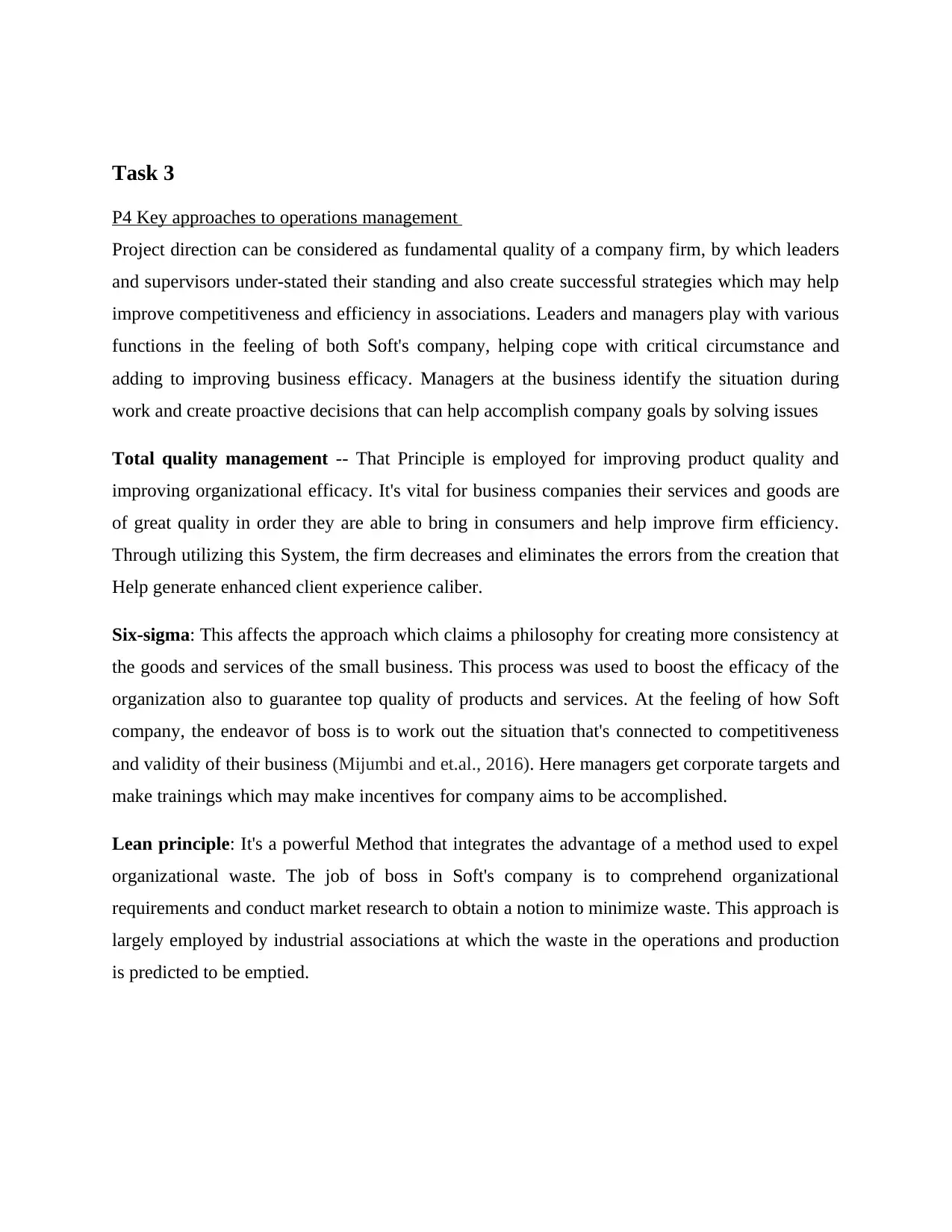
Task 3
P4 Key approaches to operations management
Project direction can be considered as fundamental quality of a company firm, by which leaders
and supervisors under-stated their standing and also create successful strategies which may help
improve competitiveness and efficiency in associations. Leaders and managers play with various
functions in the feeling of both Soft's company, helping cope with critical circumstance and
adding to improving business efficacy. Managers at the business identify the situation during
work and create proactive decisions that can help accomplish company goals by solving issues
Total quality management -- That Principle is employed for improving product quality and
improving organizational efficacy. It's vital for business companies their services and goods are
of great quality in order they are able to bring in consumers and help improve firm efficiency.
Through utilizing this System, the firm decreases and eliminates the errors from the creation that
Help generate enhanced client experience caliber.
Six-sigma: This affects the approach which claims a philosophy for creating more consistency at
the goods and services of the small business. This process was used to boost the efficacy of the
organization also to guarantee top quality of products and services. At the feeling of how Soft
company, the endeavor of boss is to work out the situation that's connected to competitiveness
and validity of their business (Mijumbi and et.al., 2016). Here managers get corporate targets and
make trainings which may make incentives for company aims to be accomplished.
Lean principle: It's a powerful Method that integrates the advantage of a method used to expel
organizational waste. The job of boss in Soft's company is to comprehend organizational
requirements and conduct market research to obtain a notion to minimize waste. This approach is
largely employed by industrial associations at which the waste in the operations and production
is predicted to be emptied.
P4 Key approaches to operations management
Project direction can be considered as fundamental quality of a company firm, by which leaders
and supervisors under-stated their standing and also create successful strategies which may help
improve competitiveness and efficiency in associations. Leaders and managers play with various
functions in the feeling of both Soft's company, helping cope with critical circumstance and
adding to improving business efficacy. Managers at the business identify the situation during
work and create proactive decisions that can help accomplish company goals by solving issues
Total quality management -- That Principle is employed for improving product quality and
improving organizational efficacy. It's vital for business companies their services and goods are
of great quality in order they are able to bring in consumers and help improve firm efficiency.
Through utilizing this System, the firm decreases and eliminates the errors from the creation that
Help generate enhanced client experience caliber.
Six-sigma: This affects the approach which claims a philosophy for creating more consistency at
the goods and services of the small business. This process was used to boost the efficacy of the
organization also to guarantee top quality of products and services. At the feeling of how Soft
company, the endeavor of boss is to work out the situation that's connected to competitiveness
and validity of their business (Mijumbi and et.al., 2016). Here managers get corporate targets and
make trainings which may make incentives for company aims to be accomplished.
Lean principle: It's a powerful Method that integrates the advantage of a method used to expel
organizational waste. The job of boss in Soft's company is to comprehend organizational
requirements and conduct market research to obtain a notion to minimize waste. This approach is
largely employed by industrial associations at which the waste in the operations and production
is predicted to be emptied.
Paraphrase This Document
Need a fresh take? Get an instant paraphrase of this document with our AI Paraphraser
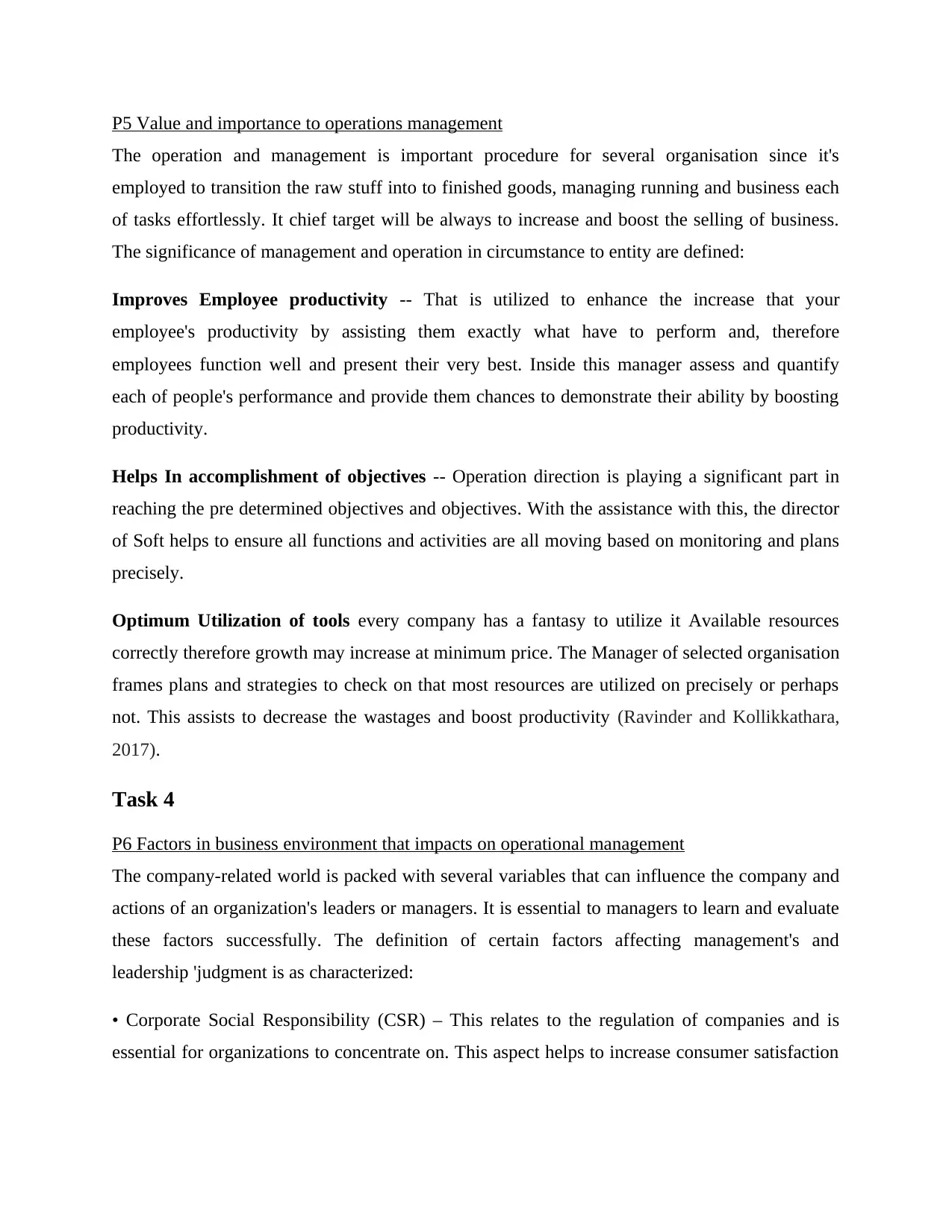
P5 Value and importance to operations management
The operation and management is important procedure for several organisation since it's
employed to transition the raw stuff into to finished goods, managing running and business each
of tasks effortlessly. It chief target will be always to increase and boost the selling of business.
The significance of management and operation in circumstance to entity are defined:
Improves Employee productivity -- That is utilized to enhance the increase that your
employee's productivity by assisting them exactly what have to perform and, therefore
employees function well and present their very best. Inside this manager assess and quantify
each of people's performance and provide them chances to demonstrate their ability by boosting
productivity.
Helps In accomplishment of objectives -- Operation direction is playing a significant part in
reaching the pre determined objectives and objectives. With the assistance with this, the director
of Soft helps to ensure all functions and activities are all moving based on monitoring and plans
precisely.
Optimum Utilization of tools every company has a fantasy to utilize it Available resources
correctly therefore growth may increase at minimum price. The Manager of selected organisation
frames plans and strategies to check on that most resources are utilized on precisely or perhaps
not. This assists to decrease the wastages and boost productivity (Ravinder and Kollikkathara,
2017).
Task 4
P6 Factors in business environment that impacts on operational management
The company-related world is packed with several variables that can influence the company and
actions of an organization's leaders or managers. It is essential to managers to learn and evaluate
these factors successfully. The definition of certain factors affecting management's and
leadership 'judgment is as characterized:
• Corporate Social Responsibility (CSR) – This relates to the regulation of companies and is
essential for organizations to concentrate on. This aspect helps to increase consumer satisfaction
The operation and management is important procedure for several organisation since it's
employed to transition the raw stuff into to finished goods, managing running and business each
of tasks effortlessly. It chief target will be always to increase and boost the selling of business.
The significance of management and operation in circumstance to entity are defined:
Improves Employee productivity -- That is utilized to enhance the increase that your
employee's productivity by assisting them exactly what have to perform and, therefore
employees function well and present their very best. Inside this manager assess and quantify
each of people's performance and provide them chances to demonstrate their ability by boosting
productivity.
Helps In accomplishment of objectives -- Operation direction is playing a significant part in
reaching the pre determined objectives and objectives. With the assistance with this, the director
of Soft helps to ensure all functions and activities are all moving based on monitoring and plans
precisely.
Optimum Utilization of tools every company has a fantasy to utilize it Available resources
correctly therefore growth may increase at minimum price. The Manager of selected organisation
frames plans and strategies to check on that most resources are utilized on precisely or perhaps
not. This assists to decrease the wastages and boost productivity (Ravinder and Kollikkathara,
2017).
Task 4
P6 Factors in business environment that impacts on operational management
The company-related world is packed with several variables that can influence the company and
actions of an organization's leaders or managers. It is essential to managers to learn and evaluate
these factors successfully. The definition of certain factors affecting management's and
leadership 'judgment is as characterized:
• Corporate Social Responsibility (CSR) – This relates to the regulation of companies and is
essential for organizations to concentrate on. This aspect helps to increase consumer satisfaction
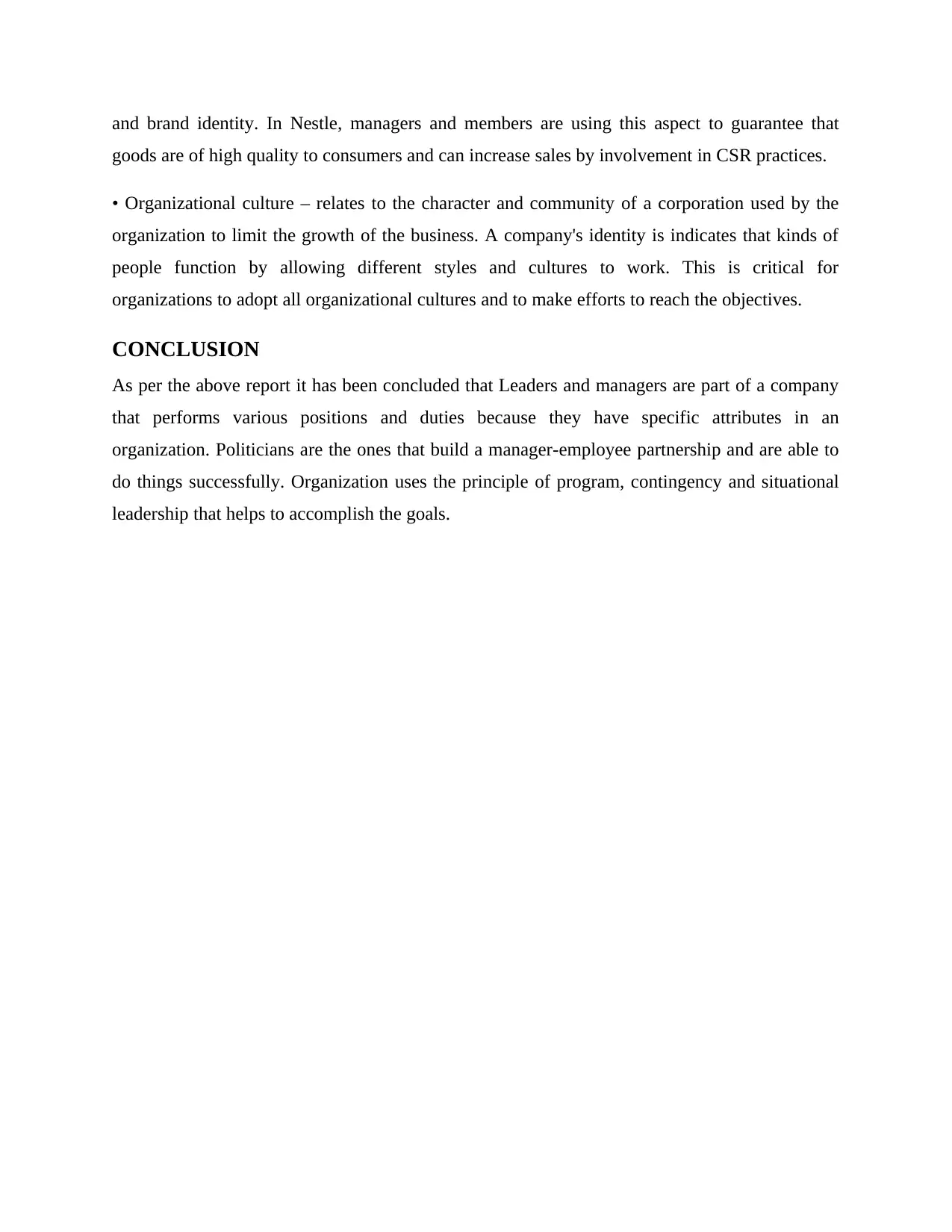
and brand identity. In Nestle, managers and members are using this aspect to guarantee that
goods are of high quality to consumers and can increase sales by involvement in CSR practices.
• Organizational culture – relates to the character and community of a corporation used by the
organization to limit the growth of the business. A company's identity is indicates that kinds of
people function by allowing different styles and cultures to work. This is critical for
organizations to adopt all organizational cultures and to make efforts to reach the objectives.
CONCLUSION
As per the above report it has been concluded that Leaders and managers are part of a company
that performs various positions and duties because they have specific attributes in an
organization. Politicians are the ones that build a manager-employee partnership and are able to
do things successfully. Organization uses the principle of program, contingency and situational
leadership that helps to accomplish the goals.
goods are of high quality to consumers and can increase sales by involvement in CSR practices.
• Organizational culture – relates to the character and community of a corporation used by the
organization to limit the growth of the business. A company's identity is indicates that kinds of
people function by allowing different styles and cultures to work. This is critical for
organizations to adopt all organizational cultures and to make efforts to reach the objectives.
CONCLUSION
As per the above report it has been concluded that Leaders and managers are part of a company
that performs various positions and duties because they have specific attributes in an
organization. Politicians are the ones that build a manager-employee partnership and are able to
do things successfully. Organization uses the principle of program, contingency and situational
leadership that helps to accomplish the goals.
⊘ This is a preview!⊘
Do you want full access?
Subscribe today to unlock all pages.

Trusted by 1+ million students worldwide
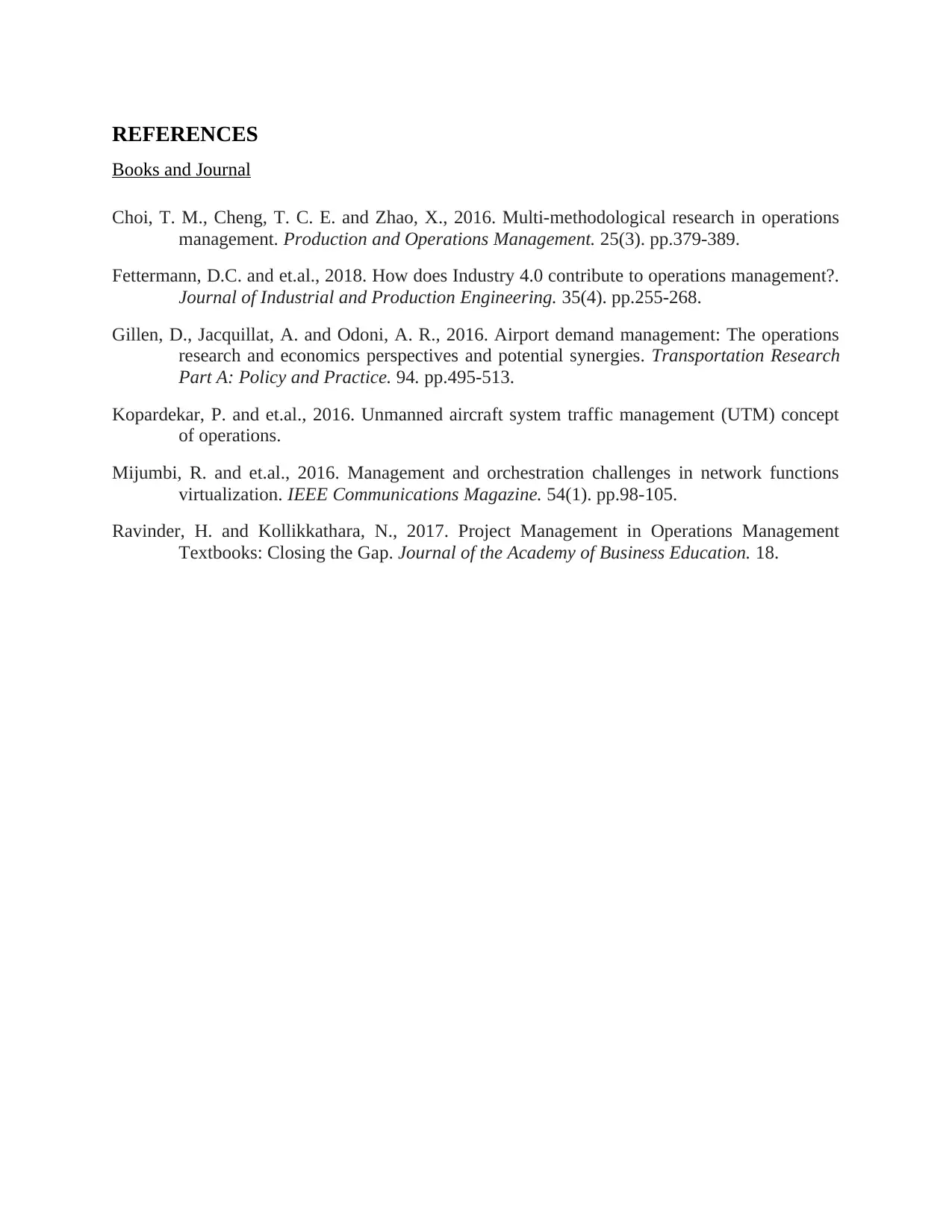
REFERENCES
Books and Journal
Choi, T. M., Cheng, T. C. E. and Zhao, X., 2016. Multi‐methodological research in operations
management. Production and Operations Management. 25(3). pp.379-389.
Fettermann, D.C. and et.al., 2018. How does Industry 4.0 contribute to operations management?.
Journal of Industrial and Production Engineering. 35(4). pp.255-268.
Gillen, D., Jacquillat, A. and Odoni, A. R., 2016. Airport demand management: The operations
research and economics perspectives and potential synergies. Transportation Research
Part A: Policy and Practice. 94. pp.495-513.
Kopardekar, P. and et.al., 2016. Unmanned aircraft system traffic management (UTM) concept
of operations.
Mijumbi, R. and et.al., 2016. Management and orchestration challenges in network functions
virtualization. IEEE Communications Magazine. 54(1). pp.98-105.
Ravinder, H. and Kollikkathara, N., 2017. Project Management in Operations Management
Textbooks: Closing the Gap. Journal of the Academy of Business Education. 18.
Books and Journal
Choi, T. M., Cheng, T. C. E. and Zhao, X., 2016. Multi‐methodological research in operations
management. Production and Operations Management. 25(3). pp.379-389.
Fettermann, D.C. and et.al., 2018. How does Industry 4.0 contribute to operations management?.
Journal of Industrial and Production Engineering. 35(4). pp.255-268.
Gillen, D., Jacquillat, A. and Odoni, A. R., 2016. Airport demand management: The operations
research and economics perspectives and potential synergies. Transportation Research
Part A: Policy and Practice. 94. pp.495-513.
Kopardekar, P. and et.al., 2016. Unmanned aircraft system traffic management (UTM) concept
of operations.
Mijumbi, R. and et.al., 2016. Management and orchestration challenges in network functions
virtualization. IEEE Communications Magazine. 54(1). pp.98-105.
Ravinder, H. and Kollikkathara, N., 2017. Project Management in Operations Management
Textbooks: Closing the Gap. Journal of the Academy of Business Education. 18.
1 out of 10
Related Documents
Your All-in-One AI-Powered Toolkit for Academic Success.
+13062052269
info@desklib.com
Available 24*7 on WhatsApp / Email
![[object Object]](/_next/static/media/star-bottom.7253800d.svg)
Unlock your academic potential
Copyright © 2020–2025 A2Z Services. All Rights Reserved. Developed and managed by ZUCOL.




